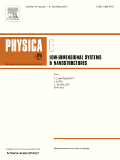
PHYSICA E-LOW-DIMENSIONAL SYSTEMS & NANOSTRUCTURES
metrics 2024
Pioneering research in condensed matter and nanostructures.
Introduction
PHYSICA E-LOW-DIMENSIONAL SYSTEMS & NANOSTRUCTURES, published by ELSEVIER, is a premier journal dedicated to advancing the field of condensed matter and nanoscience, focusing on the innovative properties and applications of low-dimensional systems. With an esteemed Q2 ranking in multiple categories including Atomic and Molecular Physics, Condensed Matter Physics, and Nanoscience for 2023, this journal serves as a vital platform for researchers and professionals aiming to disseminate and discuss cutting-edge research. Established in 1974 and converging its focus from 1997 onwards, PHYSICA E captures the evolving landscape of material science, making it a crucial resource for anyone invested in the dynamics of electronic, optical, and magnetic materials. Although the journal operates on a subscription basis, its broad accessibility and significant placement within Scopus rankings—such as being in the 83rd percentile for Condensed Matter Physics—underscore its importance within the academic community. Researchers and students alike will find this journal a cornerstone for fostering knowledge and collaboration in the fields of nanotechnology and low-dimensional physics.
Metrics 2024
 0.53
0.53 2.90
2.90 2.70
2.70 112
112Metrics History
Rank 2024
Scopus
IF (Web Of Science)
JCI (Web Of Science)
Quartile History
Similar Journals
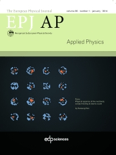
EUROPEAN PHYSICAL JOURNAL-APPLIED PHYSICS
Fostering Collaboration in Cutting-edge ResearchEUROPEAN PHYSICAL JOURNAL-APPLIED PHYSICS, published by EDP SCIENCES S A in France, serves as a vital platform for the dissemination of cutting-edge research in the fields of condensed matter physics, electronic, optical and magnetic materials, and instrumentation. With an ISSN of 1286-0042 and E-ISSN of 1286-0050, this journal has been a valuable resource for researchers since its inception in 1998, aiming to foster innovation and dialogue among professionals and academics alike. Featuring an impact factor that reflects its growing influence, the journal is currently ranked in the Q4 quartile for several related categories in 2023, underscoring its ongoing contributions to the scientific community despite its relatively competitive positioning. Access to the journal is available through various Open Access options, ensuring that pioneering research is readily accessible to all. As it continues to evolve towards its 2024 objectives, EUROPEAN PHYSICAL JOURNAL-APPLIED PHYSICS remains dedicated to advancing knowledge and facilitating collaboration in applied physics, making it an essential resource for students, researchers, and professionals dedicated to exploring the forefront of physical sciences.

Condensed Matter
Fostering Collaboration in Condensed Matter ResearchCondensed Matter is a leading open-access journal dedicated to the diverse and dynamic field of condensed matter physics, published by MDPI since 2016. With its base in Switzerland, the journal aims to present a platform for researchers and professionals to share innovative findings and advancements in areas such as electronic, optical, and magnetic materials. As of 2023, it is ranked in the Q3 category for both condensed matter physics and electronic, optical, and magnetic materials, a testament to its relevance and growth within the scientific community. Researchers will find valuable insights through its accessible format, fostering collaboration and knowledge dissemination within this interdisciplinary field. With a commitment to enhancing the global dialogue in condensed matter studies, Condensed Matter invites contributions that explore theoretical and experimental approaches, thus pushing the boundaries of understanding in this crucial area of science.

SEMICONDUCTORS
Shaping the landscape of advanced material science.SEMICONDUCTORS, published by PLEIADES PUBLISHING INC, is a prominent journal that provides a platform for researchers and professionals in the fields of Atomic and Molecular Physics, Condensed Matter Physics, and Electronic, Optical and Magnetic Materials. With an ISSN of 1063-7826 and an E-ISSN of 1090-6479, the journal has been diligently disseminating knowledge since its inception in 1996 and continues to pave the way for innovative research until 2024. Although currently unclassified in the Open Access model, its influence is underscored by its rankings in Scopus, where it ranks in the 21st-22nd percentile across critical scientific categories. SEMICONDUCTORS serves as an essential resource for cutting-edge research, fostering a greater understanding of semiconductor materials and their applications, thereby assisting the scientific community in pushing the boundaries of technology and innovation.

npj Quantum Materials
Advancing Knowledge in Quantum Technologiesnpj Quantum Materials is a premier, peer-reviewed academic journal published by NATURE PORTFOLIO, focusing on the transformative field of quantum materials. Launched in 2016, this open-access journal aims to bridge the gap between theoretical advances and experimental discoveries, providing a platform for researchers to share cutting-edge findings in condensed matter physics and materials science. With a prestigious Q1 ranking in both Condensed Matter Physics and Electronic, Optical and Magnetic Materials, it stands out in its field, boasting impressive Scopus rankings—#34 out of 434 in Condensed Matter Physics and #39 out of 284 in Electronic, Optical and Magnetic Materials, putting it in the 92nd and 86th percentiles, respectively. The journal emphasizes collaborative efforts that drive innovation and application in quantum technologies, making it an essential resource for researchers, professionals, and students eager to contribute to this rapidly evolving discipline. Accessible to a global audience, npj Quantum Materials continues to shape the future of quantum research through its high-quality publications and community engagement.
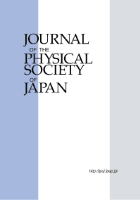
JOURNAL OF THE PHYSICAL SOCIETY OF JAPAN
Connecting Theory with Application in PhysicsThe JOURNAL OF THE PHYSICAL SOCIETY OF JAPAN, published by the Physical Society of Japan, has been at the forefront of advancing knowledge in the field of Physics and Astronomy since its inception in 1946. With a commendable reputation reflected in its Q2 ranking within its category for 2023, this journal serves as a vital platform for disseminating high-quality research and innovative concepts. Researchers and professionals alike can engage with cutting-edge studies and reviews that span a diverse range of topics pivotal to the physical sciences. Although the journal does not currently operate with an open access model, it maintains a robust impact on the global physics community, evidenced by its placement in the 59th percentile among a competitive pool of 243 journals. With an unwavering commitment to bridging theory and application, the JOURNAL OF THE PHYSICAL SOCIETY OF JAPAN continues to inspire and cultivate scholarly discourse and collaboration across disciplines.
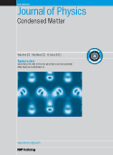
JOURNAL OF PHYSICS-CONDENSED MATTER
Fostering Dialogue Between Academia and Industry in Physics.JOURNAL OF PHYSICS-CONDENSED MATTER, published by IOP Publishing Ltd, stands as a premier platform for the dissemination of impactful research in the fields of condensed matter physics and materials science. Since its inception in 1989, this journal has successfully bridged the gap between fundamental and applied research, delivering cutting-edge findings pertinent to both the academic community and industry professionals. Ranking in the Q2 category for both Condensed Matter Physics and Materials Science, it holds a respectable position within the scientific community, as evidenced by its Scopus rankings. With a commitment to fostering innovative research and promoting open dialogue, the journal offers a substantial collection of articles that contribute to the evolving landscape of materials science and physics. Researchers and students are encouraged to engage with the journal’s rich content, which not only enhances their academic pursuits but also plays a crucial role in advancing technologies based on solid-state materials.

JETP LETTERS
Pioneering Research, Inspiring InnovationJETP LETTERS, published by MAIK NAUKA/INTERPERIODICA/SPRINGER, is a prestigious journal in the field of physics and astronomy, which plays a pivotal role in disseminating groundbreaking research and innovative ideas since its inception in 1969. With an ISSN of 0021-3640 and an E-ISSN of 1090-6487, this journal aligns well with the interests of both seasoned researchers and emerging scholars, having achieved a 2023 category rank of Q3 for miscellaneous topics within physics and astronomy. Located in the United States at 233 SPRING ST, NEW YORK, NY 10013-1578, JETP LETTERS serves as a critical resource for its readership, offering exclusive insights and advancements across diverse areas of physics. While not open access, it hosts a collection of articles that refine theoretical approaches and experimental methods, providing both knowledge and inspiration to professionals and academics seeking to make impactful contributions to the scientific community. The journal’s quality is reflected in its Scopus ranking, where it stands at 39 out of 81 in the multidisciplinary category, placing it in the 52nd percentile, thus underscoring its significance and reliability as a scholarly outlet.

PHYSICS OF THE SOLID STATE
Pioneering Discoveries in Solid-State PhysicsPhysics of the Solid State is a distinguished journal published by Pleiades Publishing Inc., focusing on the rapid advancements and fundamental research in the realms of condensed matter physics, electronic, optical, and magnetic materials. With an ISSN of 1063-7834 and an E-ISSN of 1090-6460, this journal serves as a crucial platform for disseminating high-quality research findings, insights, and reviews essential for both academic and industrial professionals in the field. As of 2023, its Scopus ranking places it in the 26th percentile for both Condensed Matter Physics and Electronic, Optical and Magnetic Materials, reflecting its evolving influence and contribution to the scientific community. Although currently classified in the Q4 quartile, the journal aims to foster interdisciplinary dialogue, improve research visibility, and enhance its impact on contemporary scientific challenges through rigorous peer-reviewed articles and focused special issues. Despite its traditional model of access, it continues to play a pivotal role in engaging researchers and fostering innovation in solid-state physics.

Journal of Ovonic Research
Advancing the Frontiers of Material Science.Journal of Ovonic Research is a distinguished publication dedicated to advancing the fields of electronic, optical, and magnetic materials. Published by VIRTUAL CO PHYSICS SRL, this journal offers a platform for researchers to share innovative findings and developments that push the boundaries of technology and materials science. With an ISSN of 1842-2403 and an E-ISSN of 1584-9953, it provides an important service to the academic community, particularly within Romania and beyond. Despite its recent inception in 2011, the journal has gained traction in the academic landscape, reflecting a Q4 quartile ranking in crucial categories such as Electronic, Optical and Magnetic Materials, as well as in Physics and Astronomy. The Scopus rankings further underscore its positioning, ranking within the 25th to 37th percentile across various disciplines, making it a valuable resource for professionals and students alike. Although the journal currently operates on a non-open access basis, it remains committed to exploring the latest advancements in materials science, encouraging interdisciplinary collaboration and fostering a deeper understanding of surface, coating, and film technologies. As the field evolves, Journal of Ovonic Research stands as a beacon for scholarly communication, bridging the gap between research and practical application.
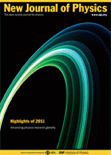
NEW JOURNAL OF PHYSICS
Transforming research into accessible knowledge for all.NEW JOURNAL OF PHYSICS, published by IOP Publishing Ltd, is a prestigious open-access journal that has been at the forefront of the physics community since its inception in 1998. With an impact factor that places it in the Q1 category of Physics and Astronomy (miscellaneous) and a commendable ranking of #49 out of 243 in the general physics and astronomy category according to Scopus, this journal is recognized for its significant contribution to advancing research in the field. The journal caters to a broad scope of topics, providing a platform for the dissemination of cutting-edge research findings and innovative theoretical explorations. Operating from the United Kingdom, it offers a truly international perspective, making its contents accessible and impactful to a global audience. With robust open-access options, the NEW JOURNAL OF PHYSICS ensures that research findings are freely available, promoting collaboration and knowledge sharing among researchers, professionals, and students alike. This commitment to accessibility, combined with its high-quality content, makes it an essential resource for anyone engaged in the physics community.